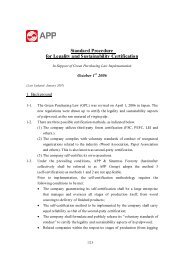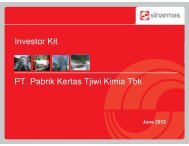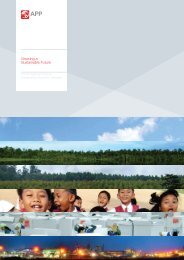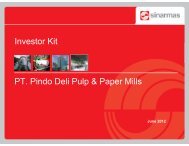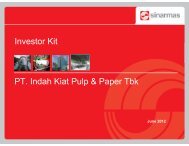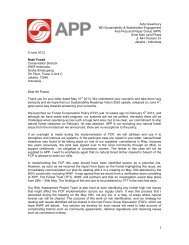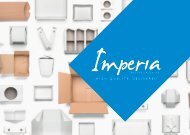APP Sustainability Report 2008-2009 - Asia Pulp and Paper
APP Sustainability Report 2008-2009 - Asia Pulp and Paper
APP Sustainability Report 2008-2009 - Asia Pulp and Paper
Create successful ePaper yourself
Turn your PDF publications into a flip-book with our unique Google optimized e-Paper software.
Sustainable Products<br />
Sustainable Products<br />
Key Process inputs<br />
We examine in more detail our two<br />
pulpwood suppliers, who provide the key<br />
raw material for our pulp mills, in chapter<br />
five. All <strong>APP</strong> pulp <strong>and</strong> pulpwood suppliers<br />
must meet the strict requirements of our<br />
procurement policy, which dem<strong>and</strong> that<br />
both domestic <strong>and</strong> imported pulpwood <strong>and</strong><br />
pulp raw materials are confirmed / certified<br />
from sustainably managed sources. <strong>APP</strong>’s<br />
environmental credentials also include the<br />
adoption of, <strong>and</strong> compliance with, a number<br />
of national <strong>and</strong> international st<strong>and</strong>ards as<br />
detailed in the product labelling section of<br />
the report.<br />
<strong>Pulp</strong>ing Raw Materials<br />
Sustainably managed, plantation-grown<br />
acacia <strong>and</strong> eucalyptus pulpwood log account<br />
for more than 80 percent of our total pulping<br />
raw material. There is also a small (<strong>and</strong><br />
diminishing) percentage of mixed wood<br />
residues arising from plantation preparation<br />
activities. We aim to be entirely supplied by<br />
forest certified wood under the m<strong>and</strong>atory<br />
certification scheme in 2015.<br />
The predominant raw material used in<br />
manufacturing <strong>APP</strong>’s high-quality printing,<br />
writing <strong>and</strong> tissue papers is bleached pulp.<br />
Our own short-fibre hardwood pulp, (Leaf<br />
Bleached Kraft <strong>Pulp</strong> / LBKP), produced at<br />
Indah Kiat Perawang <strong>and</strong> Lontar Papyrus<br />
mills, must be augmented with a limited<br />
percentage of purchased, imported longfibre<br />
softwood kraft pulp (Needle Bleached<br />
Kraft <strong>Pulp</strong> / NBKP) when used on most of<br />
<strong>APP</strong>’s paper machines. This is necessary<br />
to achieve enhanced sheet strength <strong>and</strong><br />
to improve the “runnability” or smooth<br />
operation of our high-speed paper machines.<br />
Recycling of fibre at <strong>APP</strong>’s mills is done in<br />
several ways. <strong>Paper</strong> mills are able to re-pulp<br />
any subst<strong>and</strong>ard paper that results from<br />
machine operation or paper specification<br />
problems, <strong>and</strong> to incorporate it into the<br />
pulp raw material used in production. The<br />
concern for the mill here is not any loss of<br />
raw material, but the loss of operational<br />
efficiency that this material – always referred<br />
to as “broke” – represents. Two mills, Indah<br />
Kiat Serang <strong>and</strong> Ekamas Fortuna, purchase<br />
<strong>and</strong> recycle low-grade, post-consumer<br />
wastepaper to produce packaging papers.<br />
Graphic 2 - <strong>APP</strong> Raw Material Composition<br />
* Imported fiber<br />
third party verified<br />
non- controversial<br />
sources that meet<br />
PEFC guidelines<br />
verified legal origin<br />
(legally harvested<br />
under Indonesian law)<br />
10%<br />
25%<br />
We also de-ink a small percentage of the<br />
repulped post-consumer waste to produce<br />
an upgraded pulp that can displace virgin<br />
wood pulp fibre in some paper grades.<br />
The Energy Mix<br />
Our two integrated pulp <strong>and</strong> paper<br />
operations, Lontar Papyrus <strong>and</strong> Indah Kiat<br />
Perawang, together generate about 4 million<br />
MWHr of electricity a year, in addition to all<br />
of their process steam requirements. Lontar<br />
Papyrus is essentially energy self-sufficient,<br />
while Indah Kiat Perawang does require<br />
some supplementary energy inputs. This<br />
high level of energy independence is largely<br />
due to the incineration of renewable, woodderived,<br />
process-related by-products.<br />
Much of this renewable fuel resource is in<br />
the form of “black liquor,” which comprises<br />
dissolved organic matter generated in the<br />
pulping process, plus the associated <strong>and</strong><br />
recycleable pulping chemicals. Incineration<br />
of this material as a concentrated liquor in<br />
our recovery boilers enables us to reclaim<br />
some pulping chemicals for reuse <strong>and</strong><br />
simultaneously contributes most of the<br />
energy needed at both mills. Black liquor is<br />
augmented as a fuel in separate, multi-fuel<br />
boilers with bark <strong>and</strong> other wood waste<br />
resulting from on-site wood preparation, <strong>and</strong><br />
with other purchased, waste-derived fuels,<br />
such as palm-oil mills <strong>and</strong> sawmill residues.<br />
30%<br />
35%<br />
recyled fibres<br />
<strong>and</strong> paper<br />
certified under one<br />
of the various leading<br />
certification programs:<br />
LEI, PEFC, FSC* or PHPL<br />
Indah Kiat Perawang mill converts a<br />
substantial percentage of the pulp it<br />
produces to paper on-site, <strong>and</strong> this requires<br />
some supplementary use of coal to meet<br />
that site’s overall power <strong>and</strong> process steam<br />
needs. This coal-fired generation represents<br />
approximately 20 percent of total energy<br />
inputs.<br />
To meet their energy requirements, <strong>APP</strong>’s<br />
six paper mills rely to varying degrees<br />
on a range of fossil fuels, including coal,<br />
natural gas, diesel oil <strong>and</strong> marine fuel oil,<br />
<strong>and</strong> on both purchased <strong>and</strong> self-generated<br />
electricity. In the case of Pindo Deli mill,<br />
70 percent of total steam <strong>and</strong> power<br />
requirement is generated using natural gas.<br />
At Indah Kiat Tangerang mill, waste heat<br />
from a sophisticated gas turbine power<br />
generation unit is used to augment coal-fired<br />
process steam. In addition, wastewater<br />
treatment plant sludge was also used at<br />
Indah Kiat in <strong>2008</strong> <strong>and</strong> <strong>2009</strong> as a source of<br />
renewable fuel.<br />
We are currently in the planning <strong>and</strong><br />
development stages of enabling all our<br />
paper mills to use wastewater treatment<br />
plant sludge to produce energy. The<br />
implementation will take place as soon as<br />
practicable.<br />
Chemical Inputs <strong>and</strong> Process Expertise<br />
Most chemicals from the pulp cooking<br />
process can be recovered <strong>and</strong> reused,<br />
supplemented with a small amount of<br />
fresh chemicals to maintain the correct<br />
chemical conditions <strong>and</strong> concentrations<br />
for subsequent cooking cycles. Our key<br />
process-chemical inputs include salt,<br />
limestone <strong>and</strong> sodium sulphate, <strong>and</strong> these<br />
basic, un-reactive chemical compounds<br />
are converted on-site to the highly reactive<br />
chemicals needed for the cooking <strong>and</strong><br />
bleaching processes. The relative remoteness<br />
of our two pulp mills in Sumatra means<br />
that virtually all pulping chemicals must<br />
be produced on-site. This has implications<br />
both in terms of energy requirements <strong>and</strong><br />
sophisticated chemical engineering <strong>and</strong><br />
maintenance. High-specification construction<br />
materials are needed for all the chemical<br />
processing <strong>and</strong> containment required.<br />
In our paper mills, we use a range of<br />
additives to impart specific properties to<br />
our different papers. These include fillers,<br />
such as calcium carbonate for opacity <strong>and</strong><br />
smoothness; sizes, which help manage<br />
ink penetration; starches, which provide<br />
stiffness, strength <strong>and</strong> surface properties;<br />
optical bleaching agents, used to enhance<br />
whiteness <strong>and</strong> brightness, <strong>and</strong> dyestuffs,<br />
which are used for both pastel tints <strong>and</strong><br />
highly-coloured grades. Other additives are<br />
used to enhance paper machine operational<br />
performance, improve machine drainage <strong>and</strong><br />
maintain system cleanliness.<br />
Our Tjiwi Kimia <strong>and</strong> Pindo Deli mills have a<br />
particular expertise in the coating of papers<br />
with finely ground mineral matter to produce<br />
paper surface properties suitable for a wide<br />
range of high-quality printing techniques <strong>and</strong><br />
finishes.<br />
Indah Kiat Serang <strong>and</strong> Ekamas Fortuna mills<br />
specialise in the production of packaging<br />
papers using, predominantly, lower-grade,<br />
post-consumer wastepaper as their raw<br />
material. And there is now a general move<br />
towards recycling at other <strong>APP</strong> fine-paper<br />
sites through the incorporation of some<br />
higher grades of wastepaper in response<br />
to market dem<strong>and</strong>s for recycled-content<br />
products.<br />
Any sub-st<strong>and</strong>ard or rejected product<br />
within paper mills (broke) – is recycled<br />
internally, ensuring the material is not lost<br />
from the system or wasted. Some pulpingprocess-related<br />
chemicals, surplus to on-site<br />
requirements – particularly hydrochloric<br />
acid (HCl) – are marketed externally. And<br />
two of our paper mills in Java, which are<br />
close to major urban population centres,<br />
produce chlorine on-site for sale to local<br />
municipal water purification systems <strong>and</strong><br />
industrial companies. The sodium hydroxide<br />
co-product is sold within <strong>APP</strong> to our two pulp<br />
mills for use in production.<br />
External sale of chemicals increased by some<br />
6 percent in value <strong>and</strong> tonnage in <strong>2009</strong>, in<br />
comparison to <strong>2008</strong>, but this represents less<br />
than 2 percent of total <strong>APP</strong> sales revenue.<br />
In recent decades, there have been growing<br />
international concerns about traces of<br />
dioxins found in wastewater discharges from<br />
pulp mills. This has been tentatively linked<br />
to excessive use of elemental chlorine for<br />
pulp bleaching, <strong>and</strong> has led, over time, to a<br />
marked reduction in chlorine usage worldwide,<br />
<strong>and</strong> the introduction of elementalchlorine-free<br />
(ECF) bleaching, usually in<br />
conjunction with alkaline / oxygen (A/O)<br />
<strong>and</strong>/or peroxide (H 2<br />
O 2<br />
) bleaching stages.<br />
ECF bleaching uses a diluted solution of<br />
chlorine dioxide gas – generated on-site in a<br />
sequence of electro-chemical <strong>and</strong> chemical<br />
reactions – rather than gaseous chlorine.<br />
Elemental Chlorine Free (ECF) bleaching<br />
was introduced to <strong>APP</strong> pulp mills starting<br />
1996 <strong>and</strong> have markedly increased their CF<br />
bleaching ever since.<br />
Water Management<br />
<strong>APP</strong>’s mills are typical of pulp <strong>and</strong> paper<br />
manufacturing operations in using<br />
substantial quantities of water. Indeed, pulp<br />
<strong>and</strong> paper mills worldwide are invariably<br />
located adjacent to substantial watercourses.<br />
About 85 percent to 90 percent of the water<br />
used in both integrated <strong>and</strong> st<strong>and</strong>-alone<br />
paper mills is for process purposes with<br />
some 10 percent to 15 percent used to<br />
produce steam, <strong>and</strong> for cooling associated<br />
with power generation. In aggregate, <strong>APP</strong><br />
mills drew 262 million m 3 of raw water in<br />
<strong>2009</strong>, an increase of 12 percent over the<br />
previous year. Meanwhile, water discharged<br />
directly back into rivers after wastewater<br />
treatment rose by 14 percent, to an<br />
aggregate of 190 million m 3 . The differential<br />
between raw water withdrawn from rivers<br />
<strong>and</strong> wastewater discharged is accounted for<br />
both by evaporation <strong>and</strong> by the amount of<br />
uncontaminated water used only for cooling<br />
purposes, which by-passes our wastewater<br />
treatment plants.<br />
All of our mills are legally required to<br />
monitor the composition of their wastewater<br />
discharges, with respect to the biological<br />
oxygen dem<strong>and</strong> (BOD), chemical oxygen<br />
dem<strong>and</strong> (COD), suspended solids <strong>and</strong> pH<br />
values. We must also monitor river water<br />
quality upstream <strong>and</strong> downstream of our<br />
plants. Frequently, both the upstream <strong>and</strong><br />
downstream waters are found to be outside<br />
national river water quality st<strong>and</strong>ards. This<br />
can be due to agricultural or industrial<br />
activities upstream of our operations, <strong>and</strong><br />
requires us to operate extensive raw water<br />
treatment plants, to ensure the purity of our<br />
process water.<br />
Water consumption per tonne across all of<br />
our paper mill operations increased from<br />
an average of 9.1 m 3 /tonne of production in<br />
<strong>2008</strong> to 9.9 m 3 /tonne in <strong>2009</strong>.<br />
Water usage <strong>and</strong> wastewater discharge<br />
considerations are further discussed in the<br />
individual mill sections of this report.<br />
[EN 5]<br />
[EN 10, PR 3, PR 4]<br />
24 <strong>APP</strong> 08/09 <strong>Sustainability</strong> <strong>Report</strong> <strong>APP</strong> 08/09 <strong>Sustainability</strong> <strong>Report</strong> 25



